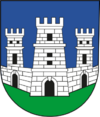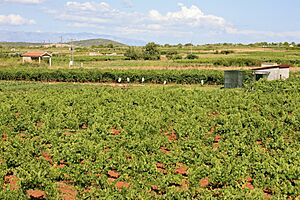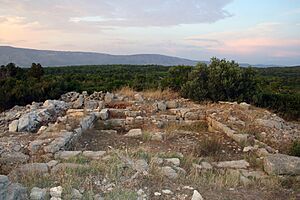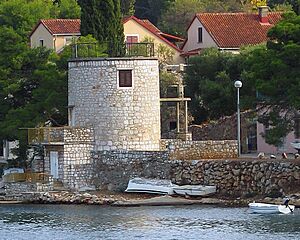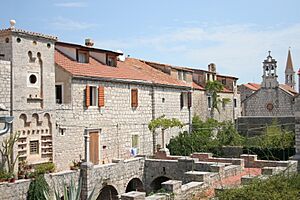Stari Grad, Croatia facts for kids
Quick facts for kids
Stari Grad
|
||
|---|---|---|
|
Town
|
||

Panoramic view of Stari Grad, seen from the bay
|
||
|
||
| Country | ||
| County | ||
| Island | Hvar | |
| Area | ||
| • Town | 52.8 km2 (20.4 sq mi) | |
| • Urban | 19.9 km2 (7.7 sq mi) | |
| Population
(2021)
|
||
| • Town | 2,772 | |
| • Density | 52.50/km2 (135.97/sq mi) | |
| • Urban | 1,921 | |
| • Urban density | 96.53/km2 (250.0/sq mi) | |
| Time zone | UTC+1 (CET) | |
| • Summer (DST) | UTC+2 (CEST) | |
| Postal code |
21460
|
|
| Area code(s) | 021 | |
Stari Grad means "Old Town" in Croatian. It is a beautiful town located on the northern side of the island of Hvar in Dalmatia, Croatia. It is one of the oldest towns in Europe.
Stari Grad is special because it sits at the end of a long, safe bay. It is also next to very good farmland. These features have made it a popular place for people to live for a very long time. The town is part of the Split-Dalmatia County.
A very old part of Stari Grad is called the Stari Grad Plain. This area is so important that UNESCO has made it a Protected World Heritage Site. This means it is a special place that needs to be preserved for everyone.
Contents
What's in a Name? The History of Stari Grad
Stari Grad was first called Faros by Greek settlers. They came from an island called Paros in 384 BC. The name Faros sounds a lot like Paros.
There's a story about a big sea battle that happened soon after the Greeks settled here. The local people, called Liburnians, didn't like the new settlers. They asked their friends for help.
About 10,000 Liburnians sailed from their capital, Idassa (Zadar). They tried to take over Faros. But a Greek fleet from Issa heard about it.
The Greek ships, called triremes, attacked the Liburnians. The Greeks won the battle. They captured many ships and people. This battle was a big deal. It made the Liburnians move away from this important area.
Later, when the Romans took over, the town was called Faria. When Slavic people arrived, they changed the name to Hvar. The main town on the island later moved to the south coast, which is now called Hvar town. So, the old town became known simply as Stari Grad, meaning "old city."
Who Lives in Stari Grad?
The area of Stari Grad has about 2,772 people living there (from the 2021 Census). About 1,921 people live in the main town itself.
There are also four other smaller villages in the area:
- Dol (311 people)
- Rudina (70 people)
- Selca Kod Starog Grada (17 people)
- Vrbanj (498 people)
| population |
4494
|
4720
|
5511
|
5990
|
5975
|
5007
|
5027
|
4258
|
3388
|
3433
|
3231
|
3016
|
2857
|
2884
|
2817
|
2781
|
2772
|
| 1857 | 1869 | 1880 | 1890 | 1900 | 1910 | 1921 | 1931 | 1948 | 1953 | 1961 | 1971 | 1981 | 1991 | 2001 | 2011 | 2021 |
Exploring the Geography of Stari Grad
Stari Grad is on the north side of Hvar island. It's at the end of a deep bay called Stari Grad Bay. Hills protect the bay to the north, and mountains protect it to the south.
East of the town is the island's best farmland. This flat, fertile area has been farmed for thousands of years. The way the ancient Greeks laid out the fields is still visible today. This is thanks to the dry stone walls that have been kept up over time. In 2008, the Stari Grad Plain became a UNESCO World Heritage site.
A Journey Through Stari Grad's History
| Historical population of Stari Grad |
||
|---|---|---|
| Year | Pop. | ±% |
| 1961 | 3,231 | — |
| 1971 | 3,016 | −6.7% |
| 1981 | 2,857 | −5.3% |
| 1991 | 2,884 | +0.9% |
| 2001 | 2,817 | −2.3% |
| 2011 | 2,781 | −1.3% |
| Source: Naselja i stanovništvo Republike Hrvatske 1857–2001, DZS, Zagreb, 2005 | ||
Early Settlements and Greek Influence
The area around Stari Grad was first settled by people from the neolithic Hvar culture. They lived on the island between 3500 and 2500 BC. These early people traded with other settlements around the Mediterranean Sea.
Archaeologists have found their pottery and other items. They also found things from the Illyrian tribe that came after them. The early settlement was at the end of Stari Grad Bay. It was protected by two forts on the hills overlooking the harbor.
In 384 BC, ancient Greeks from the island of Paros officially founded the town. They named their new settlement Faros. It was an independent state and could even make its own money.
The nearby flat land was divided into fields with roads at right angles. This ancient Greek field layout is still one of the best-preserved examples of ancient Greek farming in the Mediterranean.
Roman Rule and Changes
Around 250–231 BC, the Illyrian king Agron took control of many cities in the Adriatic, including Faros.
In 218 BC, the Romans fought the Illyrian army at Faros. The town was damaged by the Roman army. However, it stayed under Illyrian control for a while.
By 168 BC, the town was fully under Roman control. This happened after the Romans defeated the Illyrian king Gentius.
Old writings from the 2nd century BC talk about the people of Faros. They mention their trip to the Greek island of Paros and the oracle at Delphi. These writings also say that the Roman senate and people were kind to Faros.
Other discoveries like mosaics, tombstones, and pottery tell us about life in the Roman town.
Early Churches and Slavic Arrival
The first church in Stari Grad was built in the 5th century. It was in the southeast part of town, near the old city walls. In the 6th century, a new church was built on the same spot. It was a large church with a place for baptisms.
In the 7th century, the capital of the Roman province of Dalmatia, Salona, fell. Many people from Salona came to Faros and other Roman towns on nearby islands for safety.
Slavic people took over Roman Faria at the beginning of the 8th century. At this time, the town got its current name, Hvar. The letter F was not in the old Slavic alphabet.
During the 10th century, Hvar was controlled by the Narentines. Pirates from Omiš on the mainland attacked towns along the coast. Because of this, new villages grew up in the hills, like Dol, Vrbanj, and Pitve.
Venetian Influence and Ottoman Attacks
In 1278, the people of Hvar decided to be protected by the Venetian Republic. As part of this agreement, they agreed to make the settlement on the south side of the island bigger. This became the modern-day town of Hvar.
The old town of Stari Grad, also called "Old Hvar," remained important. It was the center of the most populated part of the island, especially the area around the farmland.
In the 16th century, the town was attacked by the Turks. The first time, the town fought them off. But in 1571, the Turks won, and much of Stari Grad was burned down.
After this, Stari Grad was slowly rebuilt. In the 17th and 18th centuries, the town became rich again through sea trade. The old waterfront was made longer, and the town changed a lot. This created the town we see today.
Modern Times and Tourism
In 1797, Napoleon took over the Venetian Republic. Hvar briefly became part of the Austrian Empire. When the French also took over Austria, they gave Stari Grad special status as an independent area.
After Napoleon's empire fell, Stari Grad became part of the Austro-Hungarian Empire.
The 19th century was a peaceful and rich time for the island. However, a disease called phylloxera destroyed the island's grapevines. Also, the town's sailing ships couldn't compete with new steam ships. Many people left to find new lives elsewhere.
Today, Stari Grad is growing again. Now, its main focus is tourism, attracting visitors from all over the world.
Culture and Heritage
Stari Grad has a rich cultural life and many historical sites.
- Town Music: A group of local music lovers started in 1876.
- Theatre "Petar Hektorović": An amateur theater group that started in 1893. They mostly perform funny plays.
- Town Library: This library continues the work of the "Croatian National Reading Room" from 1874. It is now in the Town Hall, built in 1893.
- Stari Grad Museum: Located in the old Palaca Biankini. It shows a rebuilt ancient Greek shipwreck and items from the Stari Grad Plain. It also has a 19th-century Captain's room. The museum has an art collection and the Juraj Plancic Gallery. (Website: Stari Grad Museum)
- Music School "Toma Cecchini": A branch of a larger music school in Split.
- Faros Kantaduri: A traditional Dalmatian singing group started in 1995. They mix old church songs with the special harmonies of Dalmatian Klapa music. (Website: www.faroski-kantaduri.hr )
- St. Stevens Church Singers: Some members also sing in Klapa "Garmica," another traditional Dalmatian singing group.
- In summer, there are many art and cultural events. These include workshops on ancient Faros, classical languages, and archaeological work. There are also open singing, puppet shows, and painting for children.
Discovering Ancient History: Archeology
The town and its surroundings are full of archaeological sites. These sites date back to prehistoric times and ancient Greek and Roman periods. The Stari Grad Museum has permanent exhibits of items found both on land and under the sea.
- Old Town Walls
- Greek settlement
- Stari Grad Plain
- Roman Villas (country houses)
- Maslinovik – a Greek tower in the Stari Grad Plain
- Glavica – an Illyrian fort above Stari Grad
- Purkin Kuk – another Illyrian fort above Stari Grad
Amazing Architecture
Stari Grad has many interesting buildings, especially churches and old homes.
- Church of St John (sv. Ivan)
- Church of St Jerome (sv. Jerolim)
- Church of St Roch (sv. Rok)
- Church of St Peter (sv. Petar), with a Dominican monastery
- Church of St Lucia (sv. Lucija), with remains of a monastery
- Church of St Nicholas (sv. Nikola)
- Church of St Stephen (sv. Stjepan)
- Chapel of Our Lady (Kapela Gospojica) in the Stari Grad Plain
- Chapel of St Helen (sv. Jelina) on the road to Dol
- Tvrdalj Castle – This was the home of the famous Renaissance poet Petar Hektorović. It was built in the 16th century.
- Trg Škor – A beautiful Baroque Square from the 17th–18th century.
- Palace Biankini – A beautiful house with a courtyard and garden. Today, it is home to the Stari Grad Museum. (Website:Museum of Stari Grad )
- House and Mausoleum of Šime Ljubića, built in a classical style in 1887.
- Old windmill (Mlin na vjetar), on the south side of the harbor.
Churches and Monasteries
The current Church of St. John and the old remains near it are from the 5th or 6th century. The original walls are still there. The church floor had cool patterns and pictures, and some are still visible. The main altar inside is very old. The big rose window on the front was added in the 14th century.
The Church of St. Rocco is named after the patron saint of Stari Grad. It was built in the 16th century. The poet Petar Hektorović helped with its construction. The bell tower was added in 1783. The main altar has a statue of St. Rocco with a dog. In 1898, an old Roman bath floor was found under the church stairs.
The Dominican monastery of St. Peter the Martyr was started in 1482. The church and monastery were attacked and burned by the Turks in 1571. After that, the monastery was made stronger with round towers.
The church was partly rebuilt in 1894. Only the bell tower and a chapel with the tomb of poet Petar Hektorović remain from the old church. The monastery museum has the oldest Greek writings from Faros (from the 4th century BC). It also has valuable paintings by Venetian artists, like "The Lamentation of Christ" by Tintoretto.
Famous People from Stari Grad
Some important people were born in Stari Grad or have roots there:
- Petar Hektorović (1487–1572): A famous poet who wrote "Ribanja i ribarskog prigovaranja".
- Šime Ljubić (1822–1896): A well-known archaeologist.
- Jakša Račić (1868–1943): A former mayor of Split.
Exploring Stari Grad's Beautiful Bays
Stari Grad Bay has many smaller bays on both sides.
- Tiha: One of the largest bays, on the northern side. It's a great place to anchor boats because it's safe and protected from all winds. The name Tiha means "silent" or "calm."
- Zavala: A slightly smaller bay, also calm, with many spots to anchor.
- Gracisce: On the south side of Stari Grad bay, this bay has a pebble beach and a thick pine forest right above it.
- Maslinica: Closer to the city on the southern side, this is a small sandy bay.
- Arkada: Located under the hotel of the same name on the northern side. It offers a calm spot for anchoring nearby.
Images for kids


